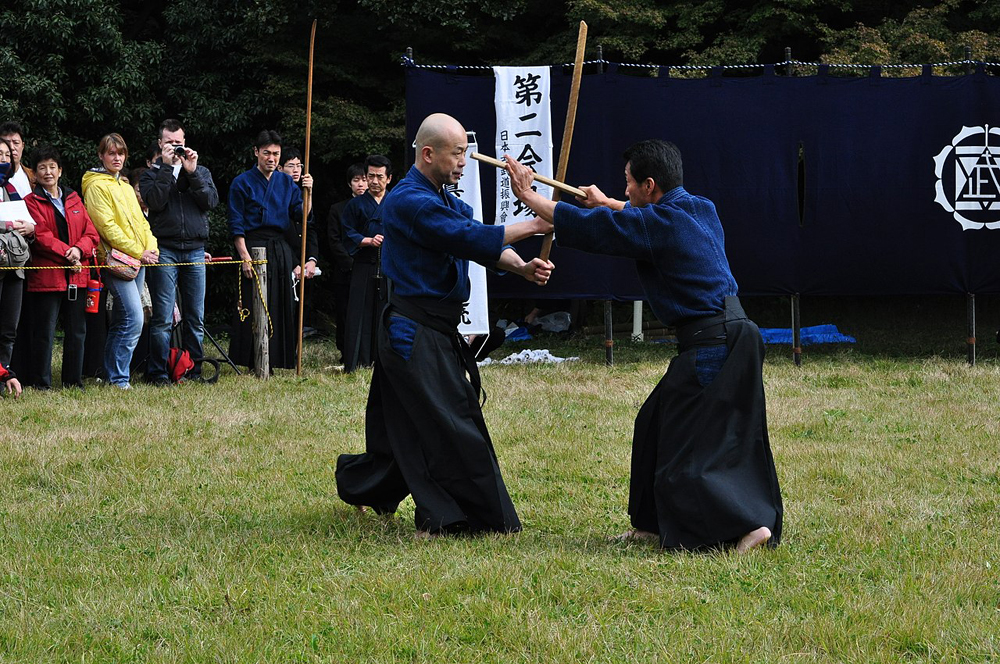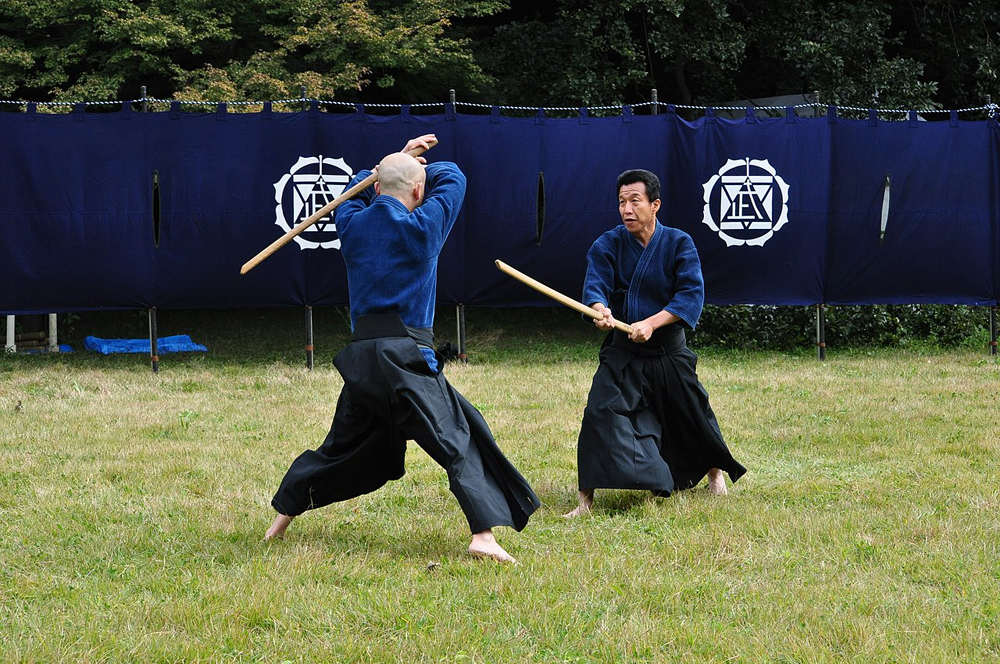By lyuesword | 23 June 2021 | 0 Comments
Recent History of Japanese Martial Art - Katori Shintō-ryū
Tenshin Shōden Katori Shintō-ryū is the source tradition of many Japanese martial arts. Several famous swordsmen (including Tsukahara Bokuden and Matsumoto Bizen no kami Masanobu) who learned directly from Chōi-sai or his immediate followers became founders of their own schools, with either the same name (Shintō, written with a variety of other characters) or different names: Kashima Shintō-ryū (Bokuden-ryū), Kashima-ryū, Kashima shin-ryū (founded by Matsumoto), Arima-ryū, Ichiu-ryū, Shigen-ryū, and others.
Iizasa devised a unique method to ensure warriors could train without serious injury and yet maintain a resemblance to 'riai' (integrity of principle) and combative reality. The weapon training of the ryū, in the form of kata-bujutsu (pre-arranged, combative training drills), illustrates this well. What appears to the outsider as merely a block of the opponent's attacking weapon is, in actuality, only a substitute for the part of the attacker's body intended to be cut or struck. Thus, full impact training could be maintained with safety to the practitioners. Thereby, he extended the training of his students to the use of other weapon systems as well, in order to be totally familiar with their capabilities and not be surprised on the battlefield by something unexpectedly different. Meiji Shrine annual festival dedication Tenshin Shinden Katori Shinto (3 November 2011)
Meiji Shrine annual festival dedication Tenshin Shinden Katori Shinto (3 November 2011)
The uniqueness of Iizasa's Tenshin Shōden Katori Shintō-ryū is still evident today, in the particular aspects of weapon-wielding, posture, stance, and foot and body movements which make allowance for the fact that the bushi (classical samurai warriors) of his era would be wearing 'yoroi' (armour) weighing around 35 kg, and fighting on uneven terrain. These factors tend to keep the wearer's feet firmly and flat on the ground, and slow down mobility considerably. The distinctive techniques and tactics of this ryū also acknowledge the design of classical Japanese armour, which, although protecting the wearer well, had many 'suki' (openings). The main attacking areas included: under the wrists; inside and behind the legs; the hip area; the space between the 'kabuto' (helmet) and 'dō' (chest protector) where the neck arteries and veins could be easily severed. The signature, 'omote' (basic-battlefield) sword technique of the ryū, 'makiuchi-jodan', was created by Iizasa because the bushi could not raise the sword above the head due to the obstruction of the kabuto, and secondly, notwithstanding that restriction, a very powerful 'chopping' blow from above was still needed to be generated in order to produce the maximum destructive force for when circumstances dictated attacking areas of the 'yoroi' other than the 'suki'.
On 6 March 1960 (昭和35年6月3日), the school received the first ever "Intangible Cultural Asset" designation given to a martial art by the Japanese government, naming Hayashi Yazaemon, Ōtake Risuke, and Iizasa Yasusada as its guardians. The Iizasa family dojo was also designated a Cultural Asset. The designation of Cultural Asset status shifted to the Chiba Prefectural Government in 1985 and the art was recertified, again naming Ōtake Risuke and Iizasa Yasusada as guardians. Ōtake Nobutoshi and Kyōsō Shigetoshi were also certified as guardians on 30 March 2004 (平成16年3月30日).
The school claims to have never aligned itself with any estate or faction, no matter what stipend was offered. This allowed the ryū to maintain its independence and integrity.
Tenshin Shōden Katori Shintō-ryū was popularised in the west by the extensive research and writings of late Donn F. Draeger (1922–1982).
The current, twentieth generation headmaster, is Iizasa Yasusada (飯篠 修理亮 快貞 Iizasa Shūri-no-suke Yasusada). He does not teach his family's system and had instead appointed as his main representative instructor Risuke Ōtake who has a personal dojo close to Narita City. Upon Ōtake Risuke's retirement, he announced his eldest son Nobutoshi would replace him as Shihan and his younger son Shigetoshi would support him as shihan-dai. Kyōsō Shigetoshi was appointed shihan in September 2017, and Ōtake Nobutoshi was issued hamon (excommunicated) on 9 December 2018. However, both Otake Risuke, Otake Nobutoshi and Kyōsō Shigetoshi are still recognised as guardians of the school, by the Chiba Prefecture Board of Cultural Affairs. Meiji Shrine annual festival dedication Tenshin Shinden Katori Shinto (3 November 2011)
Meiji Shrine annual festival dedication Tenshin Shinden Katori Shinto (3 November 2011)
Want a unique sword? Feel free to contact us:
Email: lyuesword@hotmail.com
Website: www.lyuesword.com
Custom Sword Page: www.lyuesword.com/Custom-Sword/customization-options/Create-Your-Own-Swords
Iizasa devised a unique method to ensure warriors could train without serious injury and yet maintain a resemblance to 'riai' (integrity of principle) and combative reality. The weapon training of the ryū, in the form of kata-bujutsu (pre-arranged, combative training drills), illustrates this well. What appears to the outsider as merely a block of the opponent's attacking weapon is, in actuality, only a substitute for the part of the attacker's body intended to be cut or struck. Thus, full impact training could be maintained with safety to the practitioners. Thereby, he extended the training of his students to the use of other weapon systems as well, in order to be totally familiar with their capabilities and not be surprised on the battlefield by something unexpectedly different.
 Meiji Shrine annual festival dedication Tenshin Shinden Katori Shinto (3 November 2011)
Meiji Shrine annual festival dedication Tenshin Shinden Katori Shinto (3 November 2011)On 6 March 1960 (昭和35年6月3日), the school received the first ever "Intangible Cultural Asset" designation given to a martial art by the Japanese government, naming Hayashi Yazaemon, Ōtake Risuke, and Iizasa Yasusada as its guardians. The Iizasa family dojo was also designated a Cultural Asset. The designation of Cultural Asset status shifted to the Chiba Prefectural Government in 1985 and the art was recertified, again naming Ōtake Risuke and Iizasa Yasusada as guardians. Ōtake Nobutoshi and Kyōsō Shigetoshi were also certified as guardians on 30 March 2004 (平成16年3月30日).
The school claims to have never aligned itself with any estate or faction, no matter what stipend was offered. This allowed the ryū to maintain its independence and integrity.
Tenshin Shōden Katori Shintō-ryū was popularised in the west by the extensive research and writings of late Donn F. Draeger (1922–1982).
The current, twentieth generation headmaster, is Iizasa Yasusada (飯篠 修理亮 快貞 Iizasa Shūri-no-suke Yasusada). He does not teach his family's system and had instead appointed as his main representative instructor Risuke Ōtake who has a personal dojo close to Narita City. Upon Ōtake Risuke's retirement, he announced his eldest son Nobutoshi would replace him as Shihan and his younger son Shigetoshi would support him as shihan-dai. Kyōsō Shigetoshi was appointed shihan in September 2017, and Ōtake Nobutoshi was issued hamon (excommunicated) on 9 December 2018. However, both Otake Risuke, Otake Nobutoshi and Kyōsō Shigetoshi are still recognised as guardians of the school, by the Chiba Prefecture Board of Cultural Affairs.
 Meiji Shrine annual festival dedication Tenshin Shinden Katori Shinto (3 November 2011)
Meiji Shrine annual festival dedication Tenshin Shinden Katori Shinto (3 November 2011)Want a unique sword? Feel free to contact us:
Email: lyuesword@hotmail.com
Website: www.lyuesword.com
Custom Sword Page: www.lyuesword.com/Custom-Sword/customization-options/Create-Your-Own-Swords
Leave a Reply
Your email address will not be published.Required fields are marked. *